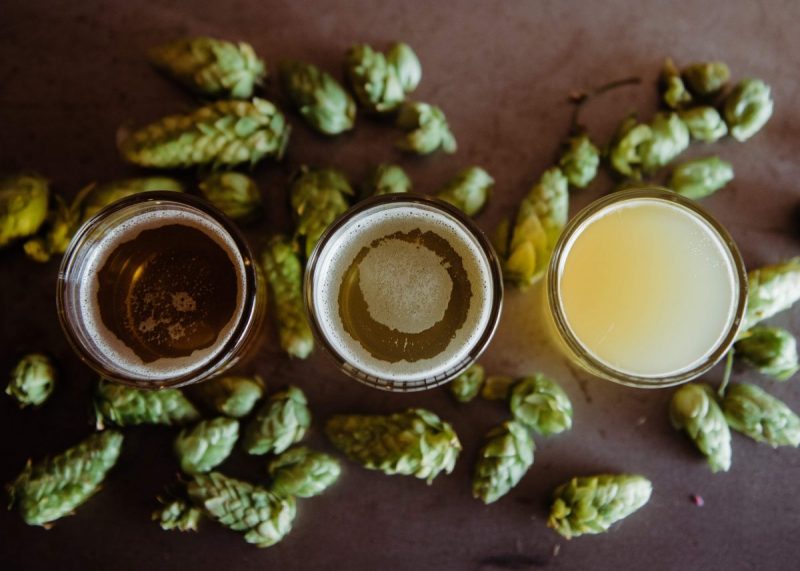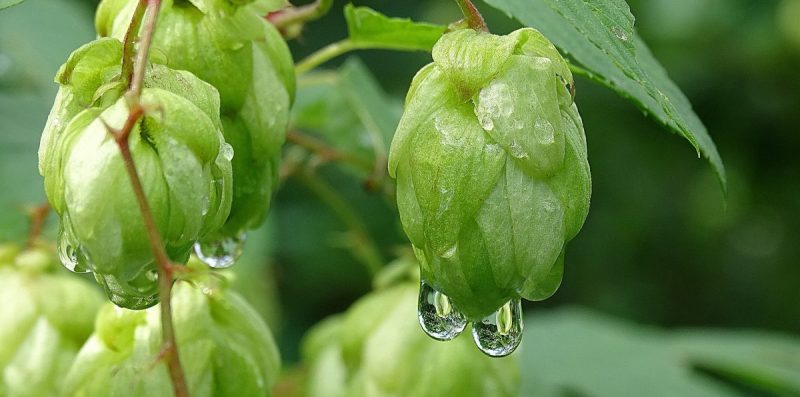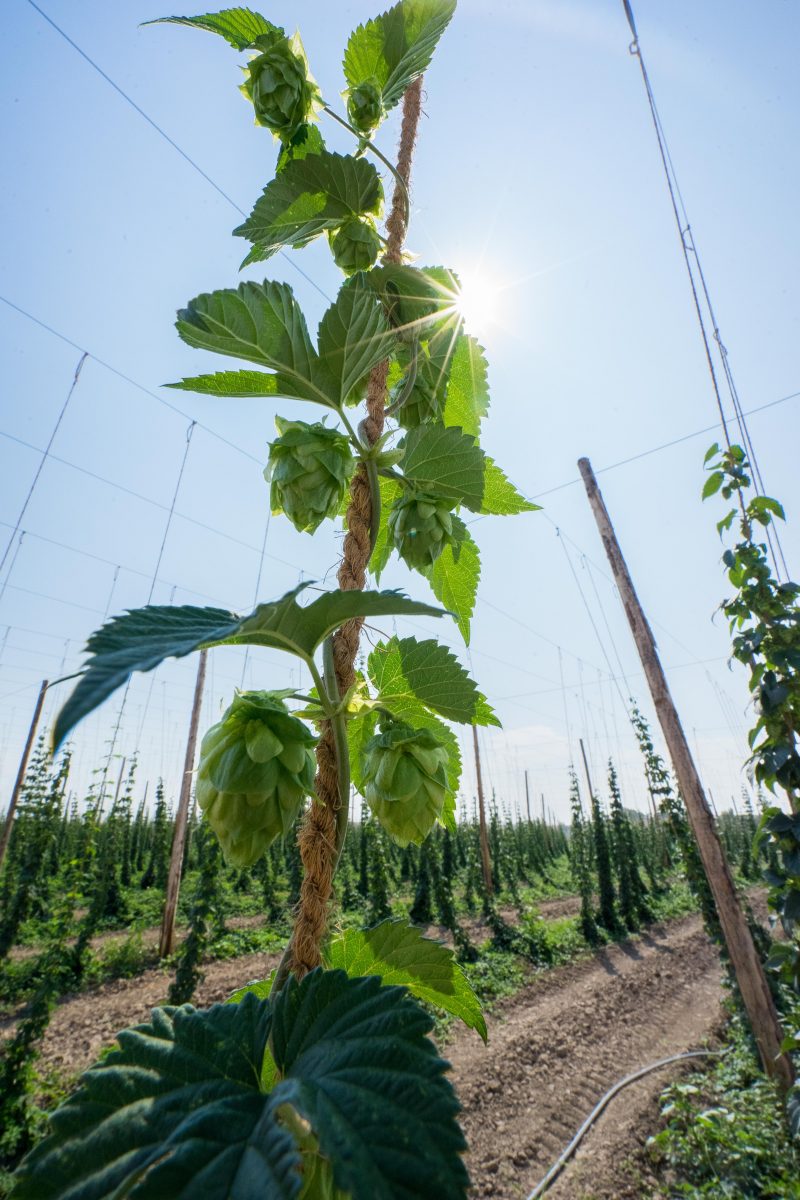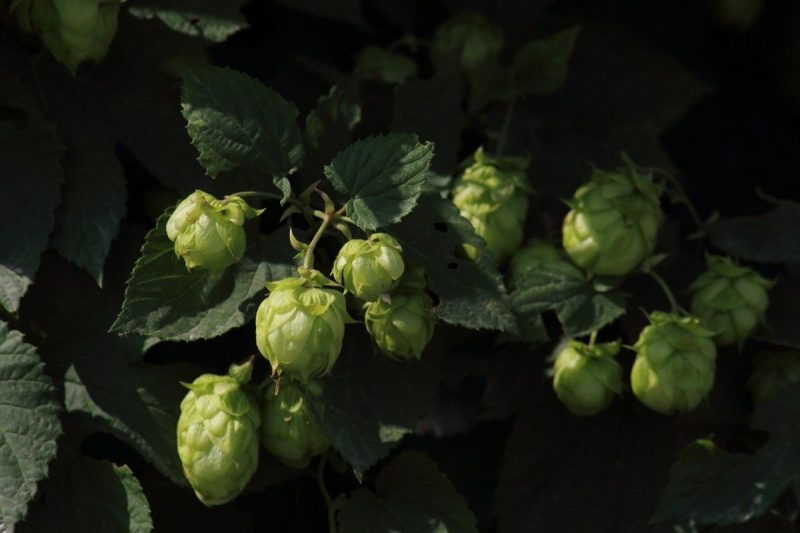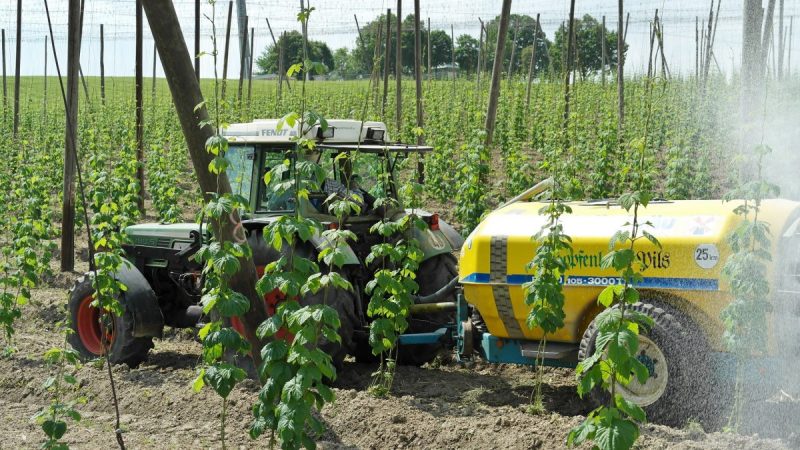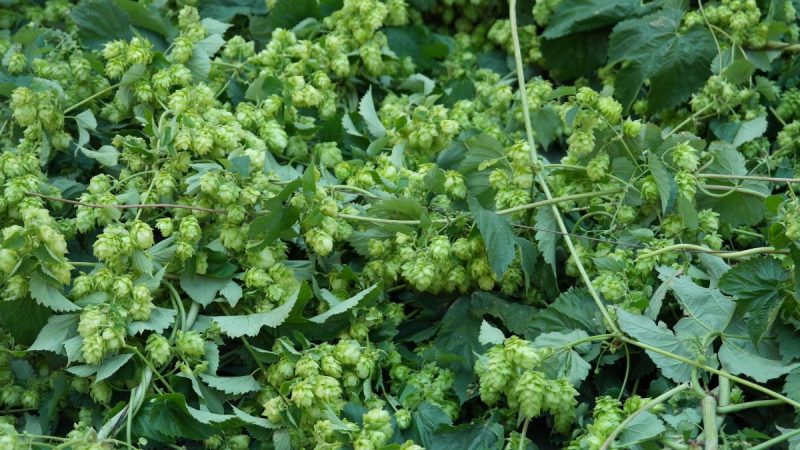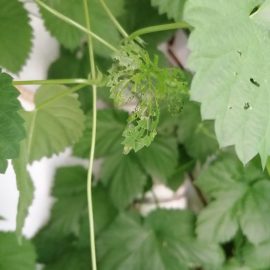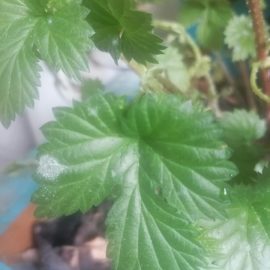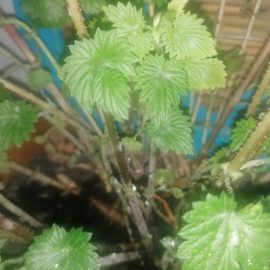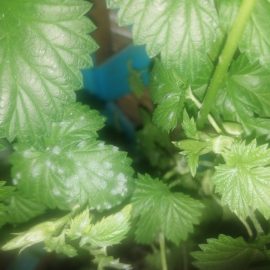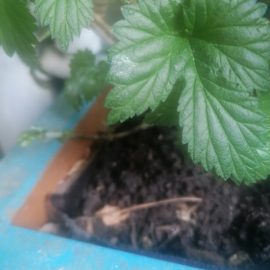Hop, cultivation and harvesting technology
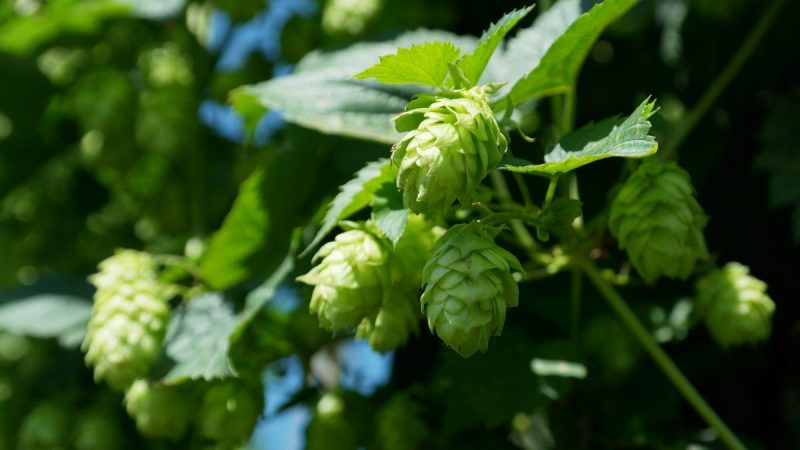
Hop – it is part of the Humulus genus, family Cannabinaceae and is one of the most important industrial crops, the cones (female inflorescences) being an indispensable raw material in the beer industry. The properties of this drink – taste and aroma, smell, foam, color, clarity and shelf life – are imprinted by the lupulin produced by the cones. Lupulin also contains bitter substances, tannins and volatile oils. Additionally, hop cones are also used for medicinal purposes, and to a small extent are used in flavoring bread.
Botanical characteristics
Hop is a perennial, long-living plant (up to 40 years old). Perenniality is ensured by the underground parts of the plant: roots, stump, stolons. The root system is strong, consisting of a rich network of roots, which can penetrate into the soil to a depth of 2-4 m.
The stump (stem) has a length of 30-40 cm, and at the topside is the “head” of the stump, found 10-15 cm below the ground level. From the stump sprout the shoots, which have a high growth rate (30-40 cm per day). When they reach a height of 50-80 cm, the stems are propped on racks, on which are twisted upwards, clockwise, with the help of hook stakes. At the level of each node, the stems sprout 2 shoots, with different lengths, depending on the vigor of the variety and the environmental conditions. The cones are formed on the lateral shoots.
The leaves form on the main stem and on the lateral shoots and have a lobed appearance. Male and female inflorescences sprout on different plants. The male inflorescences are arranged in racemes, and the female ones are arranged in peduncled catkins, which then turn into cones.
The fruit is walnut-shaped, globular. Fruit formation determines the depreciation of the qualitative properties of the cones, being an undesirable phenomenon in the hop crop.
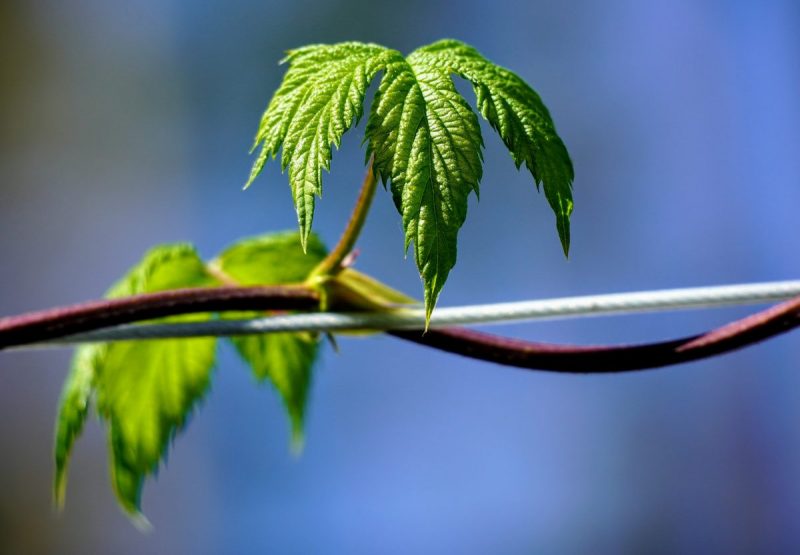
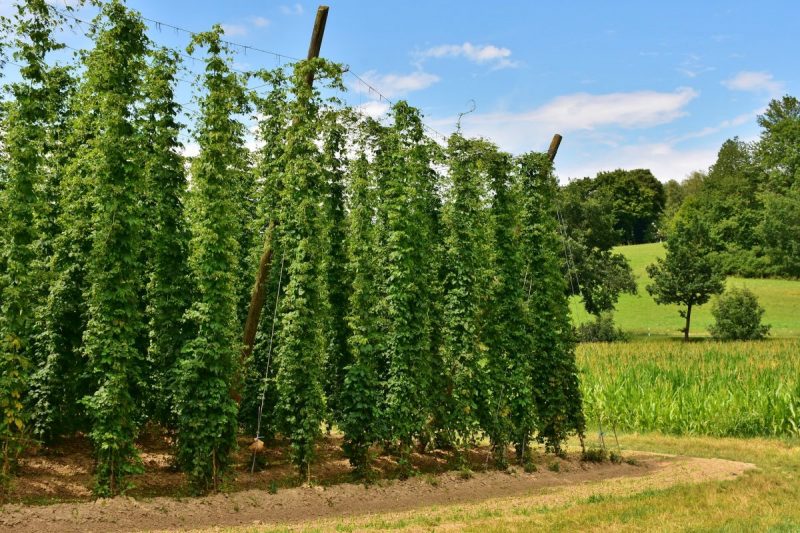
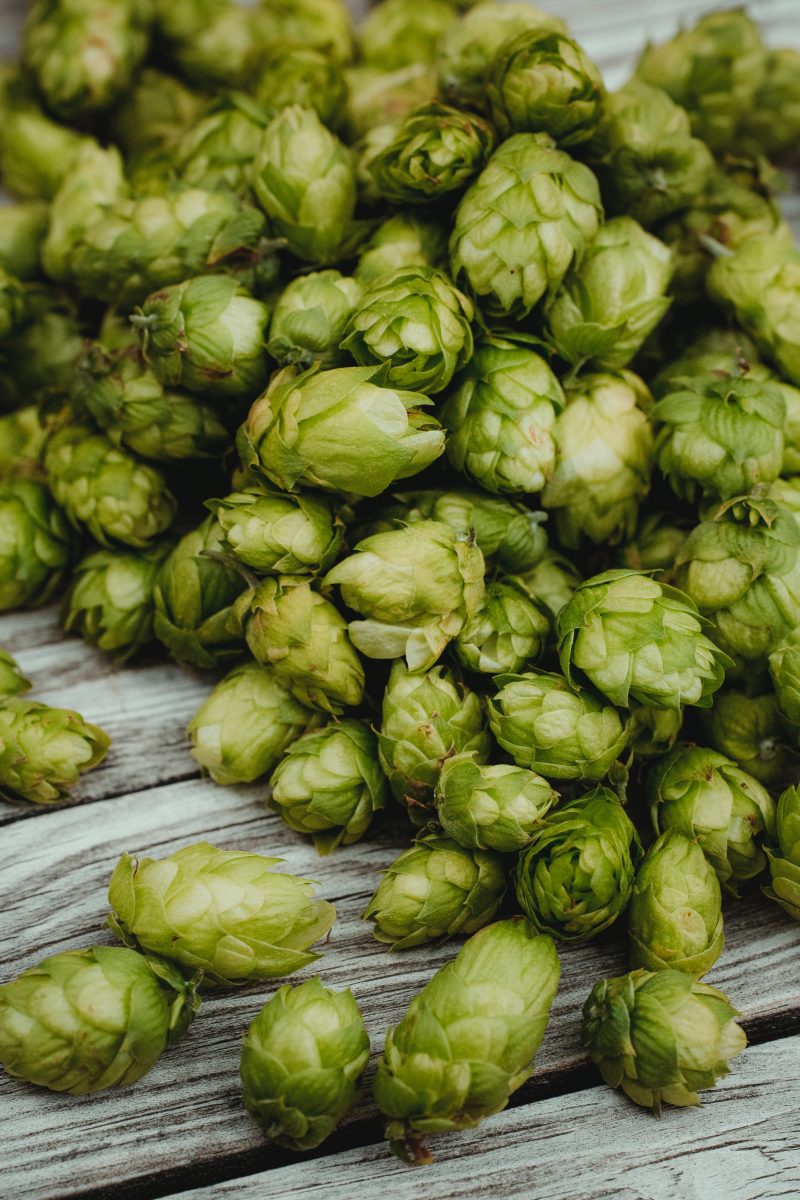
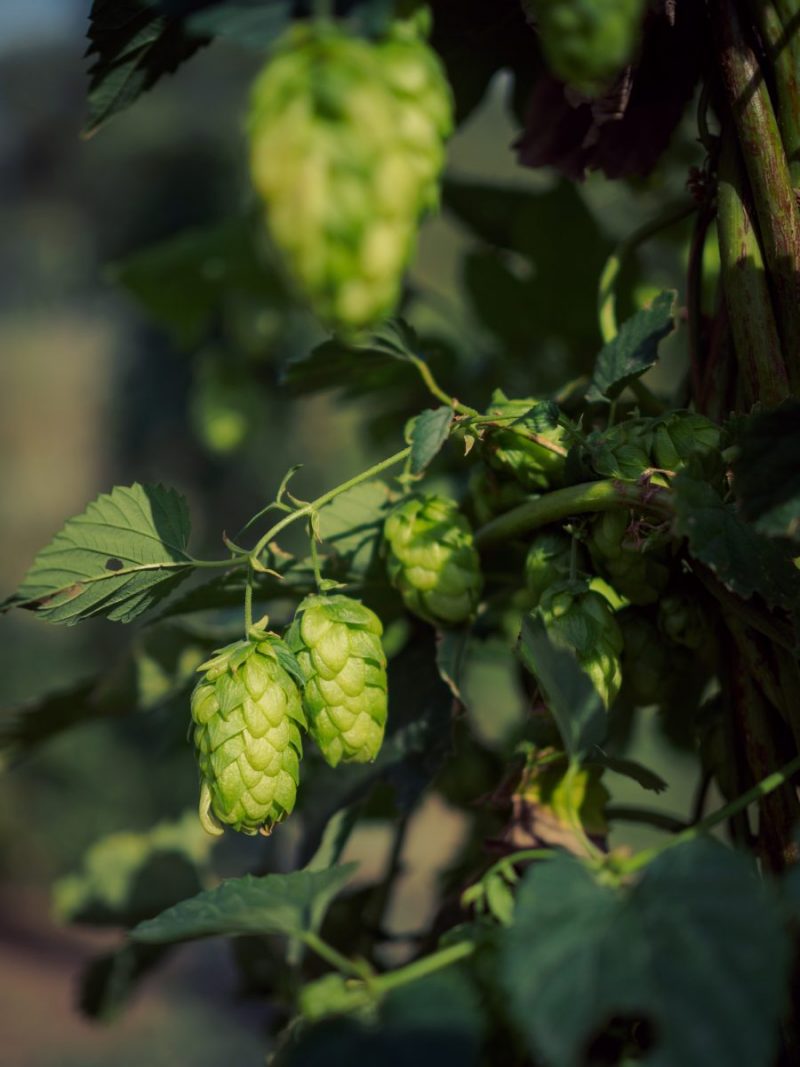
Environmental and soil requirements
Temperature
Hop has a fairly high ecological plasticity, however, the production and quality of the crop are strongly influenced by the environmental and soil conditions.
Hop requires during the vegetative growth period a sum of temperatures between 2,000-3,000 ℃, depending on the cultivated variety. In spring, at the beginning of the vegetative period, temperatures of 4-5 ℃ are required. Subsequently, during the vegetative growth, average temperatures between 14-17 ℃ are needed, and during the formation of the cones, temperatures between 17-19 ℃. High temperatures have adverse effects on the production and quality of the cones.
Humidity
Hop has high requirements in terms of humidity, which influences the production of cones and their quality. In conditions of drought and heat, the production potential of the plants decreases, and the conditions of high humidity and heat favor the appearance of diseases (especially Peronosporales). Thus, for hops, precipitation amounts between 350-400 mm are favorable, between April and August. During the flowering-cone formation (calendar: June-July), hops need a greater amount of precipitation.
Light
It positively influences the production and quality of cones. During the vegetative growth period, hop prefers cloudy days. During flowering and cone formation, it needs a longer period of sunlight.
Soil
It prefers deep, loamy or loamy-sandy soils, well drained, with a pH between 6.5-7.8. It is not recommended to cultivate on heavy, impermeable, acidic soils.
Hop cultivation technology
Trellis support system
Hop is a climbing plant, which reaches a height of 10-12 meters, requiring the construction of a support system (trellis). The trellis consists of support poles (made of steel pipes, concrete or wood), anchors, horizontal wire mesh (main and secondary), supporting wires and vertical wires.
Soil works
The first work is represented by the loosening of the soil, at a depth of 50-80 cm. This work has the role of ensuring an aero-hydric regime, which is necessary for the development of the root system. After loosening the soil, use the disc in combination with the harrow.
The preparation of the germination bed aims at leveling and loosening the soil and controlling the weeds.
Planting
For best results, it is recommended to use cuttings rooted for one year in nurseries. This way, a better rate of success is ensured starting with the first year of vegetative growth.
Hops can be planted in autumn (October-November) or spring (March-April). Planting in autumn is desirable because it ensures the development of roots and implicitly a better rate of success, as well as an earlier start of the vegetative growth period of the shoots.
When planting, it is important to ensure a distance of 3 m between rows and 1 m per row. In order to mark the place of each hole where the cuttings are to be planted, the land is picketed. The holes can be made with a drill, at a depth of 40 cm and with a diameter of 30 cm.
Planting should be done so that the topside of the cutting is 10-12 cm below the ground level, and the roots are evenly spread at the bottom of the hole. The roots are covered with soil and compacted. Hops can also be planted in ditches made at a depth of 40 cm.
Fertilization
Hop is a major consumer of nutrients. A more intense absorption is registered in July-August, when the cones are formed.
The doses are established after specific agrochemical tests of the soil are carried out. In the absence of tests and depending on the expected harvest, variety and specific absorption of NPK, the following doses are recommended: 180 kg / ha nitrogen, 160 kg / ha phosphorus and 130 kg / ha potassium. Phosphorus and potassium fertilizers are administered in the fall, by incorporation into the soil, while nitrogen fertilizers are administered in the spring.
Hop also reacts positively to the application of foliar fertilizers.
Hop care works
Weed control
The occurrence of weeds negatively influences the hop crop by consuming the nutrients from the soil and preventing the execution of maintenance and harvesting works. They are also host plants for a number of diseases and pests. Weed control can be achieved with the help of a cultivator or cutter, completed by manual weeding.
Specific herbicides will be used for chemical weed control.
Recommended products
-
You can find products on a different store
Change Store -
You can find products on a different store
Change Store -
You can find products on a different store
Change Store -
You can find products on a different store
Change Store -
You can find products on a different store
Change Store -
You can find products on a different store
Change Store -
You can find products on a different store
Change Store -
You can find products on a different store
Change Store -
You can find products on a different store
Change Store -
You can find products on a different store
Change Store -
You can find products on a different store
Change Store -
You can find products on a different store
Change Store -
You can find products on a different store
Change Store -
You can find products on a different store
Change Store -
You can find products on a different store
Change Store -
You can find products on a different store
Change Store -
You can find products on a different store
Change Store -
You can find products on a different store
Change Store -
You can find products on a different store
Change Store -
You can find products on a different store
Change Store -
You can find products on a different store
Change Store -
You can find products on a different store
Change Store -
You can find products on a different store
Change Store -
You can find products on a different store
Change Store
Controlling diseases and pests
The main diseases that can occur in hop cultivation are: Peronosporales, Powdery mildew, Verticillium, cones reddening, bacteriosis and viruses. Among the pests, the most common are: hop aphids, common red spider mites, hop flea beetles, cockchafer larvae, orange swifts and wireworms.
Recommended products
-
You can find products on a different store
Change Store -
You can find products on a different store
Change Store -
You can find products on a different store
Change Store -
You can find products on a different store
Change Store -
You can find products on a different store
Change Store -
You can find products on a different store
Change Store -
You can find products on a different store
Change Store -
You can find products on a different store
Change Store -
You can find products on a different store
Change Store -
You can find products on a different store
Change Store -
You can find products on a different store
Change Store -
You can find products on a different store
Change Store -
You can find products on a different store
Change Store -
You can find products on a different store
Change Store -
You can find products on a different store
Change Store -
You can find products on a different store
Change Store -
You can find products on a different store
Change Store -
You can find products on a different store
Change Store -
You can find products on a different store
Change Store -
You can find products on a different store
Change Store -
You can find products on a different store
Change Store -
You can find products on a different store
Change Store -
You can find products on a different store
Change Store -
You can find products on a different store
Change Store
Recommended products
-
You can find products on a different store
Change Store -
You can find products on a different store
Change Store -
You can find products on a different store
Change Store -
You can find products on a different store
Change Store -
You can find products on a different store
Change Store -
You can find products on a different store
Change Store -
You can find products on a different store
Change Store -
You can find products on a different store
Change Store -
You can find products on a different store
Change Store -
You can find products on a different store
Change Store -
You can find products on a different store
Change Store -
You can find products on a different store
Change Store -
You can find products on a different store
Change Store -
You can find products on a different store
Change Store -
You can find products on a different store
Change Store -
You can find products on a different store
Change Store -
You can find products on a different store
Change Store -
You can find products on a different store
Change Store -
You can find products on a different store
Change Store -
You can find products on a different store
Change Store -
You can find products on a different store
Change Store -
You can find products on a different store
Change Store -
You can find products on a different store
Change Store -
You can find products on a different store
Change Store
Irrigation
It is applied in the areas and during the years with precipitation deficit. The critical phases in which the need for humidity is high are: from the formation of secondary shoots to the formation of the cones (June-August).
Irrigation can be carried out by spraying (by directing the water jet at a low height: up to 2 m), by drip systems or by furrow irrigation.
Harvesting
Hop cones are harvested when they reach maturity, when they change their color from green to yellow-green and the bracts are strong. Also, when squeezing the cones between the fingers they rustle and return to their original shape. At this stage the cones have the highest content in lupulin.
Harvesting usually takes place in the second half of August – the first half of September.
Harvesting can be carried out manually or mechanically. Manual harvesting involves detaching the end of the vertical wire, which will fall to the ground along with the shoots attached to it. The cones are picked by pinching, together with 1 cm from the stalk. Mechanical harvesting is done with special harvesting machines.














































































































































































































































































































































































































































